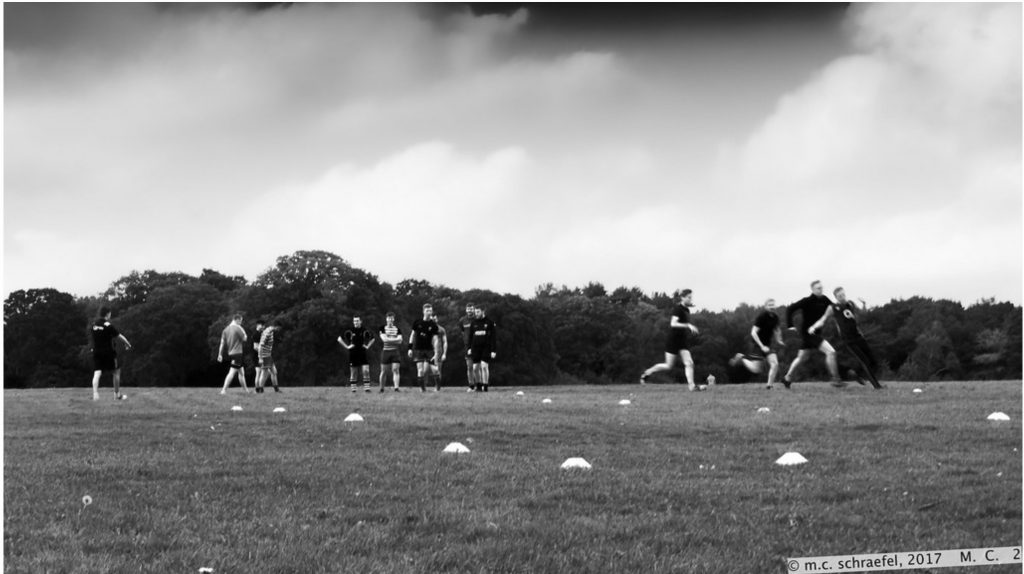Social media is the refined sugar of communication.
What does that mean?
The Tl;dr version is that social media can be thought of as refined communications like table sugar is a refined food.
A refined food has stripped out a lot of nutrients present in its whole source. Social media likewise strips out parts of – let’s coin it – “whole human communication”, like being face to face, physically co-located, identifiable, rich with multiple kinds of signals from body language to vocal tone to speed of utterance.
Whole food both provides more nutrients than refined food – and it is often more complex for our bodies to process/digest. Similarly, whole human communication is often both more meaningful and more challenging.

Social media’s stripped down comms makes incredibly easy some parts of communication. The refinement removes certain complexities that are part of whole human communication. While that removal can be seen as a plus in certain circumstances, a diet high in that kind of communication has consequences for our health and wellbeing – physically, emotionally socially.
Quality
A diet high in refined food alone leaves us malnourished; that malnourishment has knock on effects in terms of limiting our capacity for healthy physical growth, resistance to disease, and developing intelligence – both social and intellectual.
Similarly, a diet high in refined comms has knock on effects in our wellbeing. We see signs from increased anxiety and depression as just one example of negative side effects. Broader consequences are also around decision making when based on these refined information sources, and other concerns have included negative impacts on discernment in evaluating information; practicing reflection before reaction.
Our internal Wiring:
It’s important to note, too, that just as we are wired to require whole foods to best meet our nutritional needs, it seems we are also wired – including neurologically, physically – to engage in whole human communication.
And just as we need skills to learn how to find and prepare foods to make sure we get sufficient quality nutrients, we need to learn skills to be able to engage with each other – to get our social nutrients – in whole human communication.
Outsourcing
When we choose refined food/fast food, we are both outsourcing those food skills to a third party, and letting them present us – often – with poorer nutrient quality alternatives.
Similarly, when we use social media as our main type of communication, we are likewise outsourcing to that platform, what we say and how we can say it; how we can convey it. Those limitations overemphasize some types of communications while stripping out others. There are consequences to relying on outsourcing our comms, to reducing practice of whole human communication.
Please note: this is not to say that social media/fast food or table sugar is bad. It’s as in all things about our health and wellbeing, about ratios. If our diet is in the main fast food, the side effects because of poor nutrient quality can include malnourishment and obesity simultaneously.
In communication diet high in social media we spend less time learning how to cope with the challenge of in person communication, managing multiple points of view civilly, and giving ourselves time to reflect – to name a few. Its delightful ease and immediacy make too much of a good thing an imbalance. Such imbalances are not healthy, physically, socially, emotionally.

Again, social media – like table sugar – is not evil. Like a slice of birthday cake at the end of a meal on a special occasion it is a delight, a treat and a rush. But when it is our dominant form of communication, like only cake all the time, it weakens us.
——-
TL;dr –
A quick overview on Sugar as a refined food – and why high ratios of it are problematic for health.
Table Sugar is an highly refined food, where food is defined as the substances that provide nutritional support for living things. We talk about these substances as macro nutrients like carbohydrates, proteins, fats – and micro nutrients like vitamins minerals – and phytonutrients – and likely other components we haven’t yet fully identified.

Sugar has been refined from its source plant to the point that it contains only one macro nutrient: a very simple carbohydrate made up of sucrose, a disaccharide composed of two simple sugars glucose and fructose – the bottom line is that these components mean that this carbohydrate digests quickly, which further means it can provide the body a very fast source of energy.
That’s the potentially positive side. Another is sugar is used to add sweetness to foods we create to make them more tasty, more palatable. A spoon full of sugar helps the medicine go down, as the song goes.
Sugar is added to a lot of our food – even savory foods like French fries often have sugar added. Toothpaste frequently has sugar added. We crave sugar. We speak of getting a sugar hit. It’s an easy energy and mood high. It has these effects in no small part because sugar is so easy for our bodies to process, to get the energy and the palate rush.
And therein lies the problem: it’s too easy to digest, and get that rush.
Sugar exists in lots of food sources like plants naturally – fruits have sugar; many vegetables have considerable amounts of sugar too – like tomoatoes, carots, peas. But what else these plants – as whole foods – have are other nutrients that our bodies need to function. Fruits for instance have other carbohydrates than sugar – including more complex starches in their skins that slow digestion, and support the gut as prebiotics. Plants that have higher protein components like mushrooms and legumes – as well as sugars – are also more complex to digest, as well as having increased nutrient value.
The digestion slowing of having more complex types of nutrients hitting the gut is important for health. Here’s one reason why:
Because refined sugar in food digests so quickly – which means it gets into the blood stream quickly – our bodies get access to a whole lot of resource for energy production – a whole lot of calories.
As soon as that release into the bloodstream happens, the body needs to find somewhere to store all this energy resource. This is where we hear about insulin: the hormone signaling the body that there’s glucose ( a type of sugar) in the blood that needs to get put away. When we have more glucose available than we need for immediate replenishment or use, it has to get stored. Fat is where we keep excess fuel for later use.
By eating more complex or whole foods, we have a higher nutrient to fuel balance; thus, we get more nutrients and less excess material for storage. Also, that resource goes into the blood stream far more slowly, so there is a higher likelihood that we will have done something to deplete our stores (burn calories) and require replenishment, rather than need to store excess resource.

Analogy
I’m trying to frame an analogy here: a naïve one would suggest we need some logs for a fire and then we have way more logs than we can use for our needs – like a cooking fire – so we need to store the logs. There’s a cost to that storage – especially if we have to be on the move – and thus we have to take that resource with us everywhere. It’s more efficient when on the move to be able to blend some resource carried, along with gathering up what’s needed for just-in-time use. Optimal is to be able to get the minimal amount of a type of fuel that can keep the system operating as efficiently as possible.
And that’s the thing about whole food: unlike refined food like sugar that is predominantly one nutrient – carbohydrate, and so largely only valuable as an energy source – whole food provides us with more of the resources we need to keep running well – to maintain our whole bodies – which a single nutrient is insufficient to afford – and it provides better time release of those nutrients so we can use them effectively over time, too.
- m.c. schraefel, oct 8, 2019
Implications for design
For the Human Computer Interaction folks in the house, we might ask, what might more “whole communications” look like, when mediated by interactive technology.
Off the top we might say that video calling and voice calls both bring more “wholeness” to the communication. Of necessity, we are more present; more there than in text blurbs.
The literature is long around the limitations of video-based interaction in terms of constraining movement, lack of capture of whole context etc. Intriguingly, the questions raised from 30 years ago are still with us. We have likely all experienced when voice communication – perhaps enabled by wireless audio of headsets or good mics that enable us to move around while speaking – affords us more freedom to be ourselves in some ways than having to focus with a camera. Thus mechanistically, when looking to support more verisimilitude, the issues are well studied, and there’s ongoing work in that respect.
There may be ways to ask questions here that are less about improving presence, and more about the assumptions that facilitate the kinds on non-present communication that we have. Plainly, culture has a huge role to play in this space – that social media is not just a driver of change in practice, but has aligned with norms – such as convenience, speed, safety, anonymity, immediacy.
If we were to design new comms technologies, a question i would have is: what values are we designing to support? We may want to support more the kind of exchange we would have if we were in person and not in a crowd, while still being “open” to others to observe, share, comment upon. How do that? We may want to support slowing ourselves down from our own rapid reply or posting – but in order to do what?
SKILLS From my area of work in inbodied interaction, i would be asking about what are the physiological processes are at play in things like our getting triggered and our urge to rush in and correct another, or yell, or applaud, or display. I would also be look at, just as we do in other areas of health, like food, look at what is important to support.
Not Just Sugar-Free. The goal may not be to re-design the sugar, but to look at helping the person get more whole food. In the case of communication, the goal for design may be to build tools to help people become more comfortable with being physically present with others. In that case, the intervention may be: how to help people learn skills to communicate better in person? That’s currently where work in the WellthLab is focused, along with tools to help evaluate progress and feedback.
One more time: not trying to say that social media is evil; only that like sugar or other highly processed foods – social media is a refined form of human communication: it takes out the stuff that can make it challenging, time consuming, and potentially richer. And we, in our old old wiring, still need that – need to build those skills and strengths – to be fully wholly human.
What do you think?
[added oct 11]
